Disclosure: This page may contain affiliate links. Please read my disclosure for more information.
The food blog niche had the highest median monthly income of the major blogging niches in 2022. If you’ve always wanted to share your passion for food and cooking but you’re not sure how to start a food blog, you’re in the right place.
There are many reasons for starting a food blog. A few of them are:
- Sharing your love for cooking and food with the world. As a food blogger, you can share your favorite recipes, baking and cooking tips, and experiences with food.
- You can start a food blog and build a community. A food blog is a platform to connect with like-minded individuals who also share a passion for food. It can be a place where you exchange ideas, discuss recipes, and connect with others who share a similar interest in food.
- A food blog can also be an outlet for creativity and personal expression. As a blogger, you can share your cooking skills, experiment with new recipes, and show your audience your views on food, baking, and cooking.
- Starting a food blog can be a great way to earn money. You can monetize your blog through advertising, sponsored posts, affiliate marketing, courses, and by selling merch and products such as cookbooks and e-books.
- A food blog can be a way to establish yourself as an authority in the food industry and build a personal brand. You can use your blog as a platform to showcase your expertise, knowledge, and creativity. This could eventually lead to other opportunities, such as book deals, cooking classes, and TV appearances.
Steps to start a food blog:
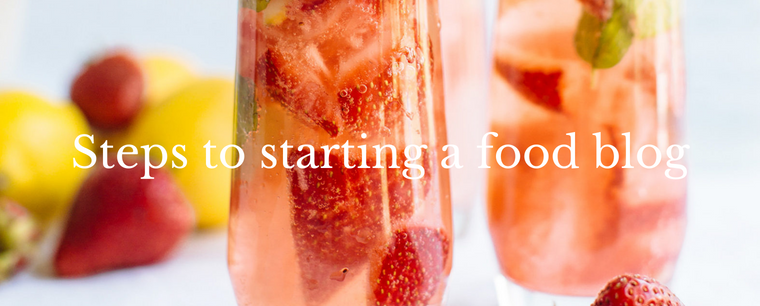
1. Define your niche
Choosing your food blog niche is an important first step in starting a successful food blog. A niche is a specific area you plan to focus on within the food blog community. By defining your niche, you can differentiate yourself from other food bloggers, become the go-to person for that area of focus and attract a specific audience.
To help define your food blog niche:
- Think about what you enjoy cooking, eating, and writing about. This can help guide you toward your niche.
- Research your competition. Look at other food blogs in your area of interest and see what sets them apart. Identify gaps in the market that you can fill with your own unique perspective.
- Consider your target audience. Think about who your target audience is and what they might be interested in. You can use tools such as Google Trends to see what topics are trending in the food world.
- Narrow down your niche. Based on your interests, research, and target audience, narrow down your niche to a specific area of focus. For example, you might choose to specialize in vegan cooking, gluten-free baking, or healthy and wellness-focused cooking.
- Try writing a few blog posts within your chosen niche to see if it feels like a good fit. You can always adjust your niche as you go along, but starting with a clear focus will help you build a consistent brand and attract the right audience.
- Write a business plan. The best way to write a business plan as food blogger is to begin by thinking about what you want to achieve with your blog business, and then work backward from there.
Potential food blog niches:
- Vegan and vegetarian cooking
- Gluten-free and other dietary restrictions
- Baking and desserts
- Comfort food and soul food
- Gourmet and elevated cuisine
- Healthy and wellness-focused cooking
- Regional and ethnic cuisine
- Grilling and barbecue
- Quick and easy meals
- Plant-based and whole-food cooking
- Gourmet sandwiches and street food
- Food and travel experiences
- Fermentation and pickling
- Cocktails and beverages
- Family-friendly and kid-approved recipes
- Seasonal and local ingredients
- Meal planning and meal prep
- Budget-friendly cooking
- High-end dining and restaurant reviews
- Sustainable and eco-friendly cooking
2. Set up your food blog
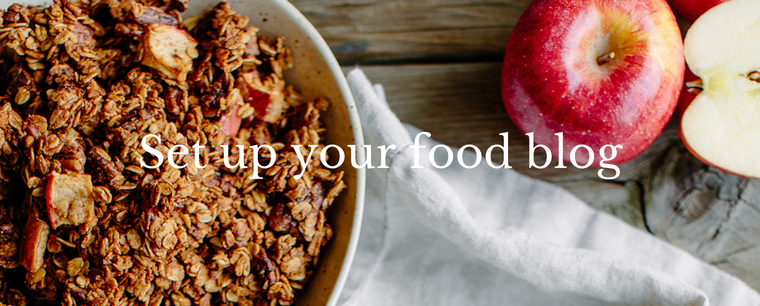
A. Name your blog and buy your domain name
Choose a blog name that is memorable, easy to spell, and reflects the content of your blog. Consider using keywords related to your niche, or use your own name if you plan to make the blog personal and share your own experiences and interests. It’s much easier to attract the right audience if you know how to choose the perfect name for your food blog.
Choose a domain name that is short, easy to remember, and matches your blog name as closely as possible. Aim for a .com extension, as this is the most commonly used and recognizable domain extension. Avoid using numbers or hyphens, as these can make the domain name harder to remember.
To purchase a domain name, you can use a domain registrar such as GreenGeeks or SiteGround. Simply search for available domains that match your desired blog name, and choose the one that you like the most. The process of buying a domain is straightforward and typically only takes a few minutes.
If you need help naming your business, read How to choose the perfect name for your online business.
B. Choose a Platform

I use Showit.co because it allows you to create a gorgeous website without having to code (unless you want to). Showit is a drag-and-drop website builder that is very easy to use. Some of the key benefits of using Showit.co for your food blog include:
- User-friendly
Showit.co is designed to be user-friendly, with a drag-and-drop interface that makes it easy to customize your website’s design, layout, and functionality. - Customizable
Showit.co offers a wide range of design templates and customization options, allowing you to create a website that is unique and reflects your brand. You can choose from pre-made free templates or purchase your own. I purchased my theme from Tonic Site Shop. - Responsive Design
Showit.co automatically adjusts your website’s layout to fit the screen size of any device, ensuring that your website looks great on both desktop and mobile devices. You do have to edit mobile and desktop separately. - Built-in SEO
Showit.co includes built-in search engine optimization (SEO) tools, making it easier for your website to rank in search engines like Google and attract more traffic. - Integration with WordPress
Showit.co integrates with WordPress, allowing you to use the powerful and flexible blogging platform for your website. This integration makes it easy to manage your blog posts, categories, and other content. - Customer support
Showit.co offers excellent customer support, with a knowledgeable and helpful team available to answer any questions and provide assistance as needed. - Hosting
Hosting is included in the monthly pricing.
C. Install necessary plugins
There are many plugins available for WordPress that can help you enhance your food blog and add new functionality. Here are two essential plugins that every food blog should consider:

Yoast SEO
This plugin helps you optimize your blog for search engines by analyzing your content and offering suggestions for improvement. It also includes features like XML sitemaps, social media integration, and meta-tag optimization.

WP Smush
This plugin optimizes images on your blog for faster loading times, reducing the load on your server and improving the user experience for your visitors.
D. Set up Google Tools
Setting up Google Analytics and Google Search Console is a great way to track website traffic for your food blog and improve your search engine rankings. Here are the steps to set up these tools:
- Google Analytics:
- Go to Google Analytics and sign up for a free account.
- Create a new property for your website and follow the instructions to add the tracking code to your website.
- Wait for data to start appearing in your Google Analytics account, which may take a few days.
- Google Search Console:
- Go to the Google Search Console and sign up for a free account.
- Add your website to your account and verify that you own the website.
- Wait for data to start appearing in your Google Search Console account, which may take a few days.
2. Create a content plan

Creating a plan for content creation, including recipes, photos, and written content, is crucial for a successful food blog. A well-structured plan will help you organize your content, ensure consistent quality, and attract and retain your audience. Here’s a guide to help you create a plan for your food blog content creation:
Create a content schedule
Decide how often you want to post new content and create a schedule for yourself. This will help you stay on track and ensure that you are consistently putting out new and fresh content for your audience.
Recipes
Choose a variety of recipes that align with your food blog niche and target audience. Make sure to include a mix of easy and more challenging recipes to keep your audience engaged. Include recipes for different meal times (breakfast, lunch, dinner, snacks, etc.).
Photos
High-quality photos are crucial for a food blog. Plan to take photos of each recipe you create, and make sure to include a variety of shots (ingredients, process shots, final product). Invest in a good camera and lighting setup to ensure your photos look professional and appealing.
Written content
In addition to recipes, consider including written content such as cooking tips, food-related articles, and personal stories. This will add depth and personality to your blog and give your audience a reason to keep coming back.
Use Surfer SEO https://get.surferseo.com/c18lm3honq82O to create topic clusters and more comprehensive coverage of a specific topic on your food blog. Topic clusters help search engines understand your website and may help see your site as an authority on a specific topic.
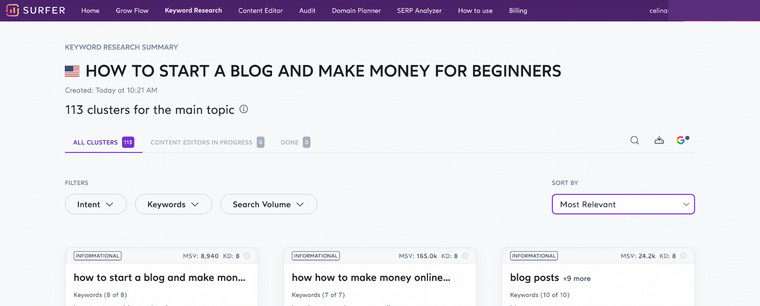
Social media
Use social media platforms to promote your blog and engage your audience. Share your new recipes and photos on platforms such as Pinterest, Instagram, Twitter, and Facebook.
Collaboration
Collaborate with other bloggers, food brands, and influencers to help grow your audience and add new perspectives to your blog. Consider hosting guest posts, participating in guest post swaps, and reaching out to food brands for potential collaborations.
Analytics
Regularly review your blog’s analytics to see what’s working and what’s not. Use this information to refine your content strategy and reach a wider audience.
3. Build an Audience
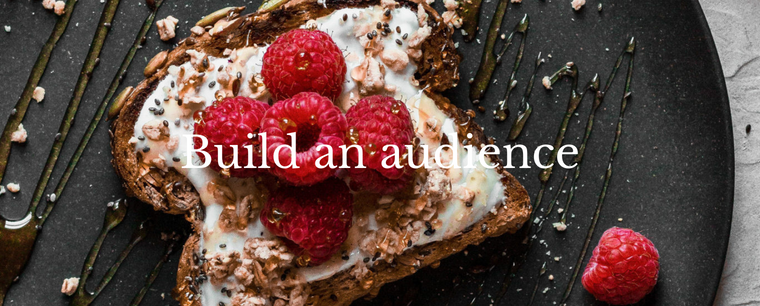
Building an audience is crucial to the success of your food blog. Here are some tips for building an engaged and loyal following:
Know your audience
Take time to understand your target audience, what they’re interested in, and what they’re looking for from your blog. This will help you create content that resonates with your audience and keeps them coming back for more.
Be active on social media
Use social media platforms like Pinterest, Instagram, Twitter, and Facebook to promote your blog and engage with your followers. Share your latest blog posts, behind-the-scenes photos, and interesting food-related content.
Collaborate with other bloggers and brands
Collaborating with other bloggers and brands in your niche can help you reach new audiences and build your own following. This could include guest posting on other blogs, hosting joint events, or partnering on recipe creations.
Optimize your blog for search engines
Make sure your blog is optimized for search engines using SEO best practices, such as using keyword-rich titles and meta descriptions, and using high-quality images.
Engage with your readers
Encourage your readers to engage with your blog by asking for their opinions, responding to comments, and offering opportunities for them to participate in your content creation.
Offer exclusive content
Consider offering exclusive content to your subscribers, such as early access to recipes, cooking tips, and behind-the-scenes content.
Invest in paid advertising
Consider investing in paid advertising to reach new audiences, such as using Facebook ads or Google AdWords.
4. Monetize your food blog
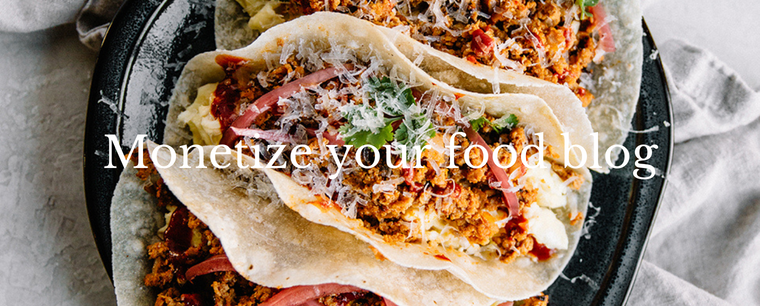
Monetizing a food blog requires a combination of strategy, creativity, and hard work. Here are some of the most common ways to monetize a food blog:
Advertising
Advertising is one of the most straightforward ways to monetize a food blog by displaying ads on your blog or partnering with brands to create sponsored content. One option for advertising on your blog is to use ad networks like Google AdSense or Mediavine, which pay you for displaying ads on your site.
Selling products
Selling products is a popular way to monetize a food blog by creating and selling products related to your blog’s niche. This could include cookbooks, kitchen tools, or food-related merchandise that resonates with your audience.
To monetize your blog with product sales, you can create an online store or use third-party marketplaces like Etsy to sell your products. Promote your products on your blog and social media channels and use high-quality photos and videos to showcase your products and encourage purchases.
Offer services
Offering services is another way to monetize your food blog by leveraging your expertise and skills in a particular area.
For example, if you are a skilled recipe developer, you could offer recipe development services to other bloggers or food businesses. Similarly, if you have a talent for food photography, you could offer food photography services to clients.
Membership programs
Monetizing your food blog with membership programs is a great way to earn recurring revenue by offering exclusive content to your most loyal readers.
To monetize your blog with membership programs, consider offering early access to recipes, cooking tips, behind-the-scenes content, or other premium content that is not available to non-members.
To attract members, you can promote your membership program on your blog and social media channels, and use high-quality video and photography to showcase the benefits of membership.
Make sure to regularly deliver high-quality content to your members, and provide excellent customer service to ensure they stay engaged and satisfied.
Classes or workshops
If you have a passion for teaching others about cooking, consider offering cooking classes or workshops. You can host in-person classes or workshops in your local area, or offer virtual classes online.
To monetize your cooking classes, you can charge a fee for attendance, or sell tickets through a platform like Eventbrite. Be sure to promote your classes through your blog and social media channels, and use high-quality video and photography to showcase your expertise and give potential attendees a taste of what they can expect.
Sponsored posts
Consider working with brands to create sponsored posts that promote their products on your blog. Sponsored posts are a great way to monetize your food blog by working with brands to promote their products and services.
To monetize your food blog with sponsored posts, you can reach out to brands in your niche, or use influencer marketing platforms that connect bloggers with brands. When creating sponsored posts, make sure to clearly disclose that the post is sponsored and that the sponsored content is relevant and valuable to your readers.
By establishing a good reputation and delivering high-quality sponsored content, you can build relationships with brands and create a sustainable source of revenue for your food blog.
e-Commerce
If you have a strong following and a loyal audience, you could consider starting an online store that sells food-related products.
Affiliate Marketing
Affiliate marketing is a great way to monetize your food blog and earn passive income by promoting products and services that are relevant to your niche. Here are some steps to help you get started with affiliate marketing:
- Look for affiliate programs that are relevant to your food blog’s niche. This could include food-related products, cooking tools, kitchen appliances, or cookbooks.
- Sign up for relevant affiliate programs and carefully review the terms and conditions of each program.
- Select products that you have used and that you believe will be valuable to your audience. Promoting products that you don’t believe in will harm your credibility and could negatively impact your blog’s success.
- Write blog posts that showcase the products you are promoting and include your affiliate links in these posts. Be transparent with your readers that you are using affiliate links.
- Use keywords and SEO best practices in your blog posts to make sure your content ranks well in search engines and is easily discoverable by your target audience.
- Use affiliate marketing tracking tools to monitor the performance of your affiliate links and see which products are generating the most clicks and conversions.
- Use the insights you gain from tracking your results to continuously optimize your affiliate marketing strategy and improve your results.
5. Conclusion
Starting a food blog requires careful planning and hard work. By defining your niche, creating high-quality content, and building an engaged audience, you can establish yourself as an authority in the food blogging world and turn your passion for food into a successful and fulfilling career. From choosing the right platform and setting up the necessary tools to promoting your content and collaborating with others in your niche, there are many factors to consider when starting a food blog. With dedication, creativity, and a commitment to providing value to your readers, you can turn your food blog into a thriving and successful business.
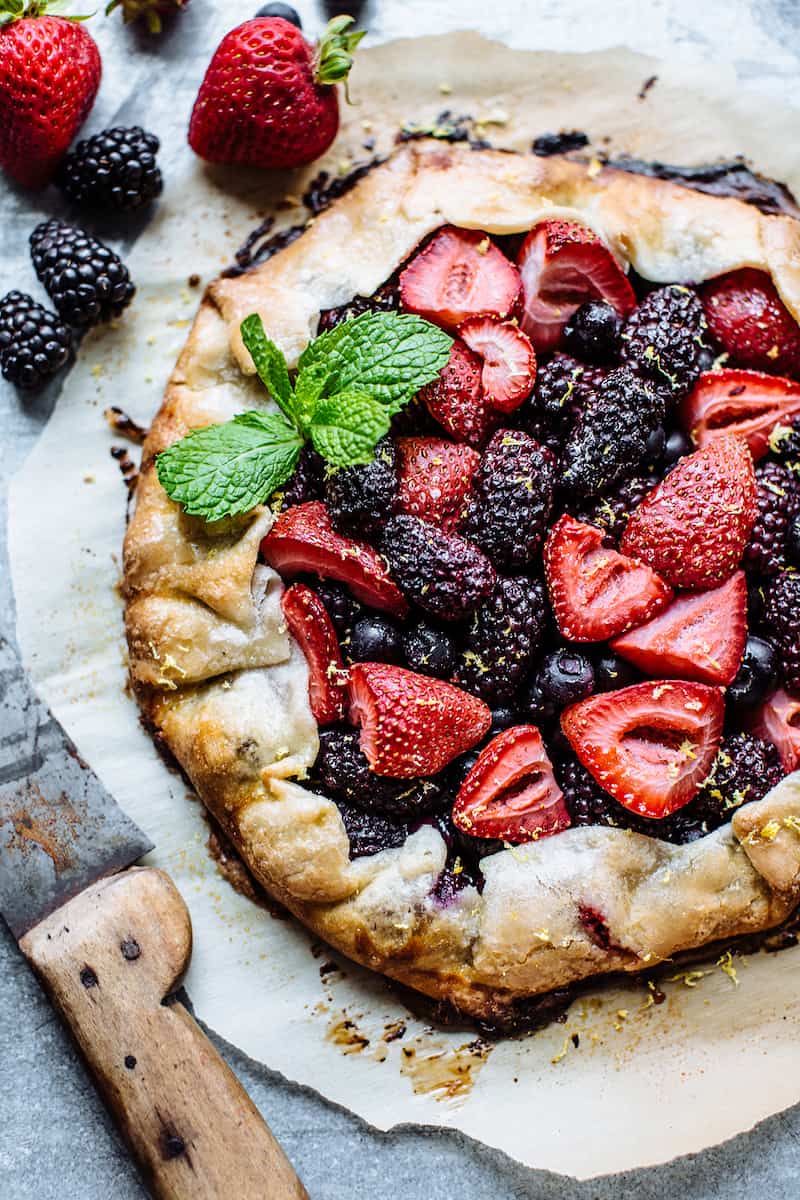
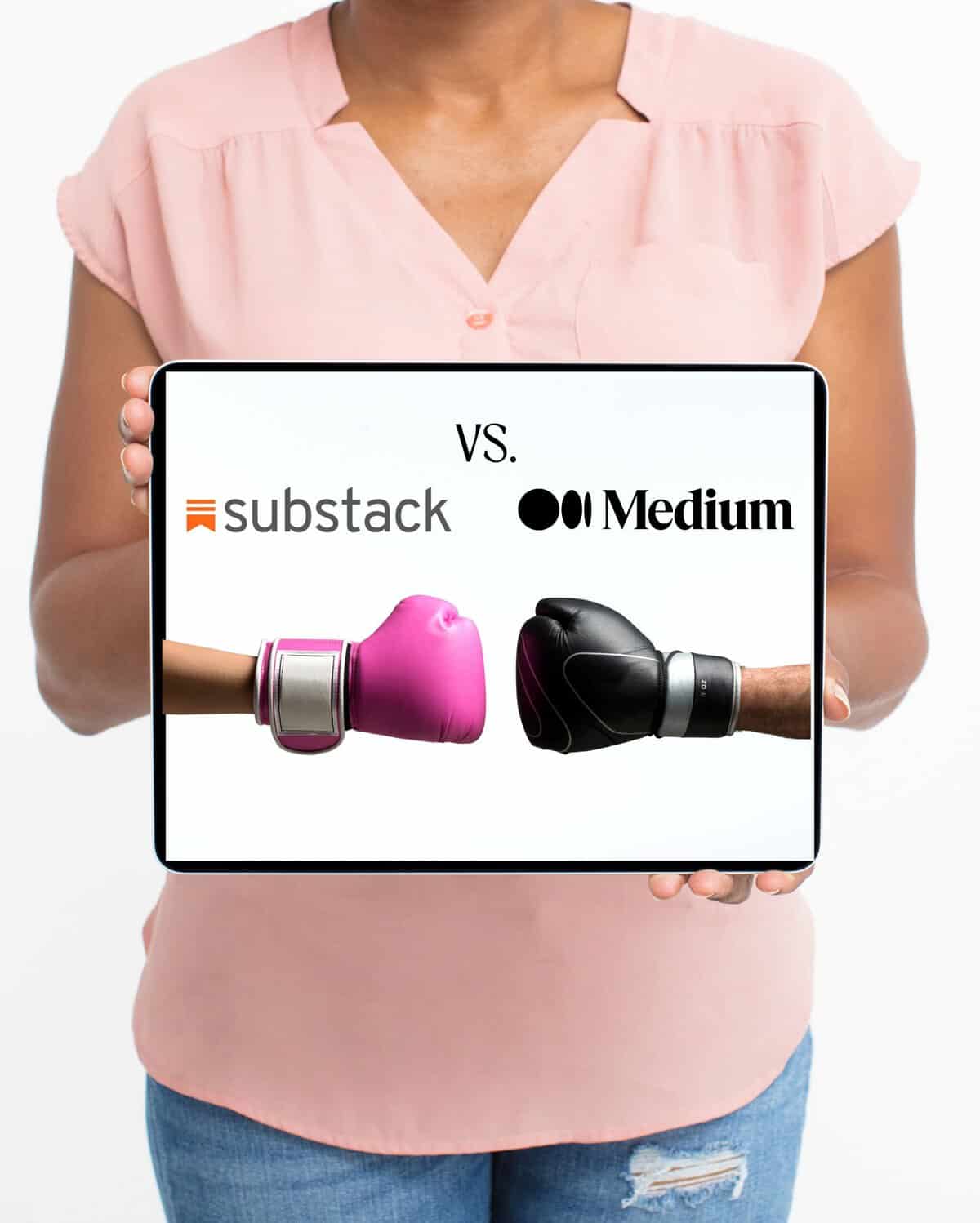
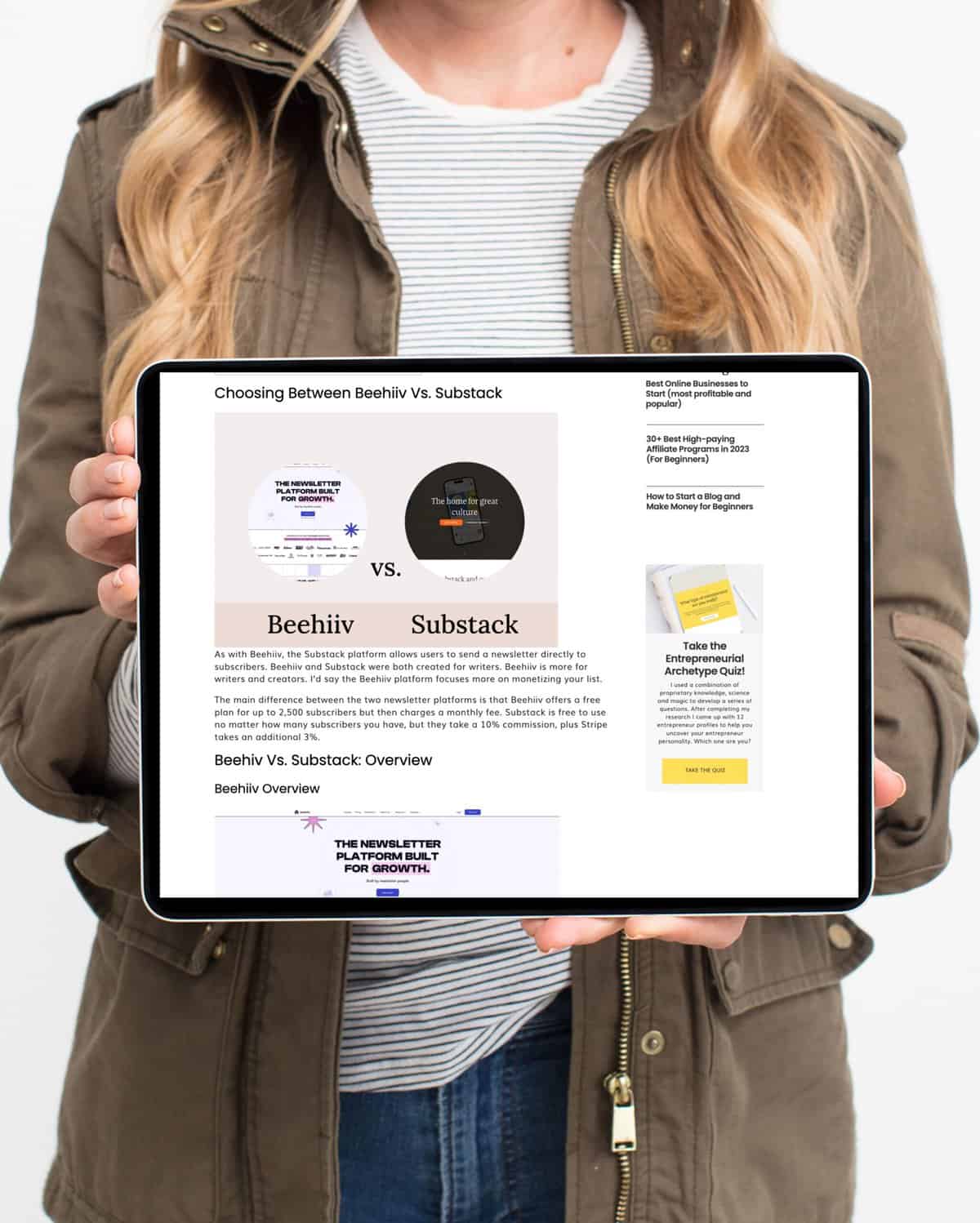




+ show Comments
- Hide Comments
add a comment